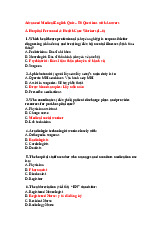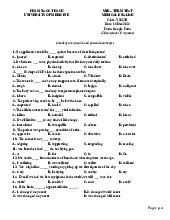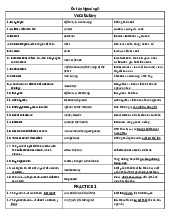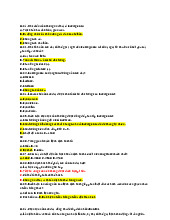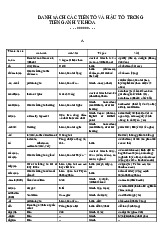











Preview text:
2. Impact OF Sales Promotion ON Consumer Buying
Behavior A CASE OF Garments Industry OF Pakistan (
Khuram Shahzad VÀ CỘNG SỰ, 2020)
Kinh tế (Trường Đại học Y khoa Phạm Ngọc Thạch)
Studocu is not sponsored or endorsed by any college or university
International Journal of Advanced Research in Engineering and Technology (IJARET)
Volume 11, Issue 10, October 2020, pp. 104-114, Article ID: IJARET_11_10_010
Available online at http://iaeme.com/Home/issue/IJARET?Volume=11&Issue=10
ISSN Print: 0976-6480 and ISSN Online: 0976-6499
DOI: 10.34218/IJARET.11.10.2020.010 © IAEME Publication Scopus Indexed IMPACT OF SALES PROMOTION ON
CONSUMER BUYING BEHAVIOR: A CASE OF GARMENTS INDUSTRY OF PAKISTAN Khurram Shahzad
PhD (Marketing) Greenwich University Karachi, Pakistan Anam Bhatti*
Faculty of Business Management Sciences ILMA University Karachi, Pakistan Talat
University of Sargodha, Pakistan Anam Javaid
Department of Statistics, The Women University Multan Pakistan Syeda mahwish Raza Naqvi
Faculty of management Sciences, Superior University Lahore, Pakistan *Correspondence Author ABSTRACT
The study highlights the importance of sales promotional tools on consumer
buying behavior. The industry selected in the research is textile. The brands in the study
are Khaddi, Gul Ahmed, Junaid Jamshed, Alkaram, Sana Safinaz and Bonanza
Satrangi. The independent variables in the study are discounts, coupons and buy one
get one free. Consumer buying behavior was treated as a dependent variable. Survey
method was used and questionnaire was distributed to the respondents. Sample size
was 110 in the study. Pearson correlation test and regression test were applied in the
study. Discounts and coupons were strong positive relationship, whereas buy one get
one free was moderate positive relationship. Khaddi brand was found to be more
involved in sales promotional activities. More variables and increase in geographic
location are needed for future research.
http://iaeme.com/Home/journal/IJARET 104 editor@iaeme.com
Impact of Sales Promotion on Consumer Buying Behavior: A Case of Garments Industry of Pakistan
Key words: discounts, coupons, buy one get one free, consumer buying behavior
Cite this Article: Khurram Shahzad, Anam Bhatti, Talat, Anam Javaid and Syeda
Mahwish Raza Naqvi, Impact of Sales Promotion on Consumer Buying Behavior: A
Case of Garments Industry of Pakistan, International Journal of Advanced Research
in Engineering and Technology, 11(10), 2020, pp. 104-114.
http://iaeme.com/Home/issue/IJARET?Volume=11&Issue=10 1. INTRODUCTION
Promotion is a tool of marketing which is used to attract consumers in order to temporary
increase the sales of the company and attract new customers and retain the old ones. Sales
Promotion is one of the most widely used tools in marketing world. It can be said that many of
the marketing activities that we see around the world is linked with sales promotion (Bhatti,
2018). One of the benefits of sales promotion is that it gives consumers to think and
differentiate between the offerings of the brand. Sales Promotional tools usually involve
discounts, coupons, free items and samples. Sales promotion is the core of integrated
marketing communications. Different types of promotional stated that the intention of
promotional activities should be to retain consumers and attract new consumer group.
According to (Salelaw & Singh, 2016), sales promotion is a direct incentive of providing value
added product or bonuses to the consumers and the distributors. The sales technique also
encourages and plays with the minds of the consumers by inducing them towards the purchase
of products or services in bulk quantity. The sales promotional activities are time oriented and
boost the sales of the company for a short period of time. There are pros and cons of sales promotion.
Exchange, gifting, trail and testing, quantity discounts, free product or samples offer and
trade shows (Shamout, 2016). The first tool of sales promotion is discounts. The discount is a
strategy of sales which involves in cutting down the price of the product or services which the
company is offering. The discounts are offered by companies in different industries. It’s a most
common practices which the company does in order to attract consumers, retailers and
distributors. Another tool of sales is giving coupons to consumers when they purchase products
or services at a premium price.
The coupons are the way of inducing consumers for more exciting offers which the
company offers as the consumer is purchasing high end products. The coupons are mostly
associated with hotels, restaurants and corporate business. Having coupons of the brand
provides additional benefits to the end user. Sampling is the technique of sales which provides
with products or services to the consumer without charging them (Khan et al., 2019). As the
time passed away, new strategies and innovation has brought new ways of attracting
consumers. Ready-made garments are one of the most important industry when it comes to
creating income and employment in Pakistan. This sector creates up to 54% of export income.
Besides this, it creates a large portion of employment for the people and for labor in Pakistan.
The cost of labor in Pakistan is lower than some other countries. As a result, China has
started investing in this sector by purchasing raw materials and other products. The labor force
has committed towards providing 2.38% in textile products (Muhammad Abrar et al., 2018).
Garments industry in Pakistan are mostly present in Karachi, Lahore and Faisalabad. The key
players or brands in this sector are Khaddi, Gul Ahmed, Junaid Jamshed, Alkaram, Sana
Safinaz and Bonanza Satrangi. In this study, all these players would be part of this research.
The main purpose of this research paper is to study the impact of sales promotion on
consumer buying behavior and keeping in mind the industry would be garments. The study
would help recognizing which marketing tools is best suited for the companies to compete
http://iaeme.com/Home/journal/IJARET 105 editor@iaeme.com
Khurram Shahzad, Anam Bhatti, Talat, Anam Javaid and Syeda Mahwish Raza Naqvi
with the companies and on international level. Many of the promotional tools which are used
by the marketer involves discounted pricing, free samples, free coupons and buy one get one
free offer. In this research study, only three components of the sales promotional tools would
be considered namely, Discounts, coupons and buy one get one free (BOGOF). The study is
important as it can better guide the companies on which promotional tool is best suited for
them. When they know which tool is the best, the retailers or even the manufacturers can better
strategize their resources in order to gain all-out profit. Furthermore, the study would provide
insights to the players who are involved in garments industry in Pakistan and how they can
align their strategies with the tools of marketing. 1.1. Problem Statement
The study is based on the sales promotional tools and how it affects the consumer buying
behavior. Sales promotional tool is considered as an important aspect of the promotional mix.
More exactly it can be said, “How sales promotion affects consumers buying behavior in garments industry. 2. LITERATURE REVIEW
Sales promotion is one of the widely used method of promoting the product and services of the
company. The sales promotion is the second most method of communication with the consumer
after advertising. The elements that are part of the promotional mix are advertising, direct
marketing and personal selling or in other words it is called door to door sales. According to
the research of (Adeniran et al., 2016), promotion of sales is directed towards touching the
hearts of consumers. Furthermore, they
One of the benefits which sales promotion provides is that it achieves its targeted goals of
the brand by selling the item in no time. The second advantage is that it promotes or
encourages the consumer to try the product due to promotional activities. By this, there is a
high chance that the consumer would switch from the brand and become loyal to this new
brand. It can be said that although this is good benefits of sales promotion, but there are
drawbacks of too. One of the disadvantages of doing sales promotional activities is that it is a
short-term strategy (Adeniran et al., 2016). The company sales are increased for short period
and hence maximum output of generating profits cannot be achieved from this strategy.
Besides this, consumers may have high expectation of having promotional activities on a
continuous basis. This would make consumers tempted and frustrated as they would only be
loyal to the brand when these activities are launched. This strategy not only leads to lose of
consumer but also damages the brand image (Ismail & Siddiqui, 2019). Sales promotional
activities are mostly done on outdoor. The activities are carried out where there is large
number of consumer traffic such as malls, airports, concerts and amusement parks. The
location and targeting of the right consumer are the key for the success of sales promotion.
Some of the examples of sales promotion is that when a consumer buys a pair of shoes, he is
given a pair of socks free. This would bring delight on the consumer perspective and hence
would be willing to share his experience with his family and friends. This would not only bring
the consumer back to the brand but would also spread good word of mouth to the new
consumers in that area. The sales promotion tools involve discounts, coupons, sampling, The
sampling is usually done when a new product or service-oriented business is launched in the
market. The free sampling is an encouragement to the consumer so that they can get to know
the companies offering. The free sampling also helps the sales team in order to give better
feedback to the company and channel their marketing strategies. Exchange is another type of
promotion which enables the consumer to buy a different product from the one purchased
before. The trail and testing are the way through which the consumer uses or consumes the
http://iaeme.com/Home/journal/IJARET 106 editor@iaeme.com
Impact of Sales Promotion on Consumer Buying Behavior: A Case of Garments Industry of Pakistan
product. After consumption, the consumer provides his valuable feedback and what he wants
more from the brand. This enables the sales team to quickly change the strategy and make
amendments in the final delivery of the product. The quantity discounts are the method by
which company purchases items at bulk quantity, which enables them in receiving overall price discount.
This way the company purchase high quantity of products and sells them according to
added value pricing to the end user. The next is the famous promotional activity which many
people have experienced it. The buy one and get one free offer is one of the oldest and yet
successful offers which the company uses in order to clear their stocks out (Teck Weng & Cyril
de Run, 2013). These types of promotions are done in clothing line or garments. Some of the
most common example of this is the sales of Television or electronic products. 2.1. Consumer Buying Behavior
It is defined as the total amount of attitude, intent and the way a consumer makes his or her
decision in the market place. Consumer buying behavior is the most discussed topic in
marketing research. The consumer behavior is processed through recognizing the consumer
need, want, demand and desire so that they can fulfill their physical and psychological need.
According to the research of (Orji, 2017), there are many factors which influences the thought
process of the consumers in making and purchasing the decision. The marketing team needs to
find the pattern by which the consumer makes purchases in their daily life (Bhatti & Akram, 2020).
Some of the factors which are discussed in marketing research are price, motivation and
cultural importance. One of the researchers stated that pricing is the most influential factors
which can make or break the final decision for the purchase of good (Bhatti, Saad, &
Gbadebo, 2018). Sometimes it happens that many consumers do not purchase the item due to
price insensitivity and other testimonials associated with the brand (Bhatti, Saad, & Salimon,
2019). The next item is motivation. The motivation is divided into two parts namely, internal and external factors.
The internal factors are based upon the principal of continuous learning, mindset and
attitude. The external factors are based upon the salient features of cultural norms and
religious beliefs. The external factor is the riskiest as many companies need to understand the
background of the consumer belief and religious entity (Auf, 2018). One of the most
discussed topics in consumer behavior is how to control and better grip the cultural
differences that is around the world. Consumer buying behavior is now being understood and
studied in terms of religious and cultural importance of the consumers. Many of the products
and services which the company offers should be aligned with what the norms are. Many of
the company face a lot of issues when delivering products to different parts of the world. The
language, lifestyles and cultural plays a big role when studying consumer buying patterns and
behavior. So, many of the researchers have emphasized that a proper strategy and conduction
of study is necessary for the success of brand and long-term relationship between the
consumer and the organization (Samuel, 2017).
There are four types of consumer buying behavior which the consumer has to make in
terms of product differentiation, interest, level of motivation or involvement and situation.
The first type involves that the consumer is fully aware what the brand is offering and is ready
to distinguish between two or more brands. The second one is when the consumer is buying
the product, he takes pricing strategy and the risk associated with the brand into knowledge.
By this process, the consumer makes the final decision of the right to purchase the product or
to switch to other product. The second type is dissonance buying behavior. This results in the
http://iaeme.com/Home/journal/IJARET 107 editor@iaeme.com
Khurram Shahzad, Anam Bhatti, Talat, Anam Javaid and Syeda Mahwish Raza Naqvi
consumer to quickly purchase the brand and hence, consumer loses the ground to even go into
more details. This type of behavior is called dissonance buying behavior (Bhatti, Bano, &
Rehman, 2019). The third type is habitual buying behavior. These types of consumers are
very stubborn when it comes to choosing the right product. The consumer is very risk aversive
and they do very little to buy or even try out a new product. In more easy words, it can be said
that the consumer is brand loyal and they won’t switch the brand so easily (Kotler, 2015).
This type of consumer has very low involvement with the product. The last type of consumer
buyer is variety seeking. This type of consumer is very much involved in the purchase
decision and information searching of the brand (A. Bhatti & S. u. Rehman, 2019b). These
types of consumer would take their time and do a lot of information search in order to find the
best alternative. This consumer would do lot of traveling and comparing different brand
which are available in the marketplace (A. Bhatti & S. U. Rehman, 2019a). Companies needs
to understand these types of consumer in the marketplace. The concept of shelfing is very
important in order to entertain these groups of peoples. The shelf would display a large sum
of products in order to attract different category of people.
There are six stages of consumer buying process in which the individual has to go through
some steps before making the final purchasing of a product or a service. The first stage of the
buying process is the need recognition. In the first stage, the consumer goes through a series of
question which pertains to his or her requirement of an item. The need recognition is the process
through consumers fulfil their need, demand and desire. The need is either self-generated or is
being influenced by others. For example, being hungry leads to eating or consuming food. The
second stage is information search. In this stage, the person starts searching to find the best
alternative through internal or external information. The internal information is based upon
previous experiences. The external information is based upon getting to know about a certain
item through family, friends or word of mouth (Sharma, 2014). This information is more
reliable and successful in the long run.
For example, being hungry leads to food, but what kind? The third stage is the evaluation
of alternatives. In this stage, the person tries to look for alternatives. These alternatives are
ranked according to the best buy and providing the complete package. In this stage, the
consumer evaluates the criteria of his or her search. The next stage is purchase decision in
which the individual has to make the final evaluation of the product features. By this, the
person has finalized to which product to purchase. The purchase stage is when the consumer
purchases the product from the store. The next stage is the post purchase evaluation. In this
stage, the consumer goes towards being happy or unhappy with the brand. If the consumer is
unhappy, then he would not repurchase the product in the near future. If the consumer is
happy, then he would not only purchase the product but also spread good word of mouth. The
last stage is called the cognitive dissonance stage. In this stage, the consumer goes after the
warranties and after sale services of the product. By this, the brand and consumer can stay connected with each other. 2.2. Hypothesis
Ho1: Discounts have a constructive relation with consumer buying behavior
Ho2: Coupons have a constructive relation with consumer buying behavior
Ho3: BOGOF have a constructive relation with consumer buying behavior
http://iaeme.com/Home/journal/IJARET 108 editor@iaeme.com
Impact of Sales Promotion on Consumer Buying Behavior: A Case of Garments Industry of Pakistan 3. RESEARCH METHODOLOGY 3.1. Research Design
Secondary data would involve the collection of data through published reports, articles and
library. The primary data would be the firsthand knowledge of the research paper. The primary
data would be collected through the use of questionnaire (A. Bhatti & S. Rehman, 2019;
Bhatti, Shaheen, Akram, & Rehman, 2020; Bhatti., Saad, & Gbadebo, 2020). This study
would be involved with snapchat view. The snapchat view is associated with that research
which is used for academic purposes and the duration of the study is less than 2 years. More
over the longitudinal view is based upon the research study which has a duration of more than
2 years. There are three types of strategy which are used in research. In this study, the research
is based on exploratory strategy. This involves the distribution of questionnaire and the
implementation of survey method.
There are two research approaches namely, induction and deduction. The deduction
approach is used for the trail and testing of the hypothesis in a study. The deduction approach
is associated with quantitative research. The induction approach is based upon theory building
and argumentative literature in the study. This form of study is mostly done in qualitative
research. This research would follow the deduction approach.
3.2. Population and Target Population
The population that has been taken in this study would be the people Pakistan. Major cities of
Pakistan would be considered in this study. The total sample size for the study is 110.
3.3. Sample and Method of Sampling
The total number of sample size taken in this study is 110. The first ten questionnaires would
be distributed for the testing of Cronbach Alpha. Random sampling method would be used in this study.
3.4. Measurement Scale and Instrumentation
The items taken in the questionnaire were developed on the basis of sales promotion items
namely, Discounts, Coupons, BOGOF and their impact on consumer buying behavior. The
questionnaire has been made on the foundation of 5-point Likert scale. The first part of the
questionnaire is concerned with the respondent’s demographic analysis. The second part is
regarding which brand the consumer prefers. The last part is related with the questions which
are adopted from the Blackwell and Mitchell research study (Bakewell, Cathy & Mitchell,
2003). SPSS version 20 was used in order to analyze the facts and figures collected from the data. 3.5. Research Framework
http://iaeme.com/Home/journal/IJARET 109 editor@iaeme.com
Khurram Shahzad, Anam Bhatti, Talat, Anam Javaid and Syeda Mahwish Raza Naqvi Figure 1 Research Framework 4. DATA ANALYSIS 4.1. Cronbach Alpha Table 1 N % Valid 14 100.0 Cases Excluded 0 .0 Total 14 100.0
a. List wise deletion based on all variables in the procedure. 4.2. Reliability Statistics Table 2 Cronbach’s N of Items Alpha .821 15
The reliability of questionnaire has been found to be 82%, which is above the level of
70%. Hence, it can be said that the questionnaire can be distributed to the respondents.
http://iaeme.com/Home/journal/IJARET 110 editor@iaeme.com
Impact of Sales Promotion on Consumer Buying Behavior: A Case of Garments Industry of Pakistan 4.3. Demographic Analysis Table 3 Gender # of respondents Male 60 Female 50 Total 110
60 respondents were found to be male and 50 respondents were found to be female. 45% Mal 55% Female Figure 2 Table 4 Age # of respondents 18-24 41 25-31 39 32-38 15 39-45 4 More than 45 11 Total 110 37% 18-24 14% 25-31 32-38 39-45 35% Figure 3
http://iaeme.com/Home/journal/IJARET 111 editor@iaeme.com
Khurram Shahzad, Anam Bhatti, Talat, Anam Javaid and Syeda Mahwish Raza Naqvi
Most of the respondents who were part of this study were from the age bracket of 18-24
and the next age group was from 25-31, with a total number of 39.
4.5. Pearson Correlation Analysis 18% 30% Khaddi Gul Ahmed 8% Junaid Jamshed Alkaram Sana 17% Safinaz 25% Bonanza Figure 4 Table 5 Brand Preference # of respondents Khaddi 33 Gul Ahmed 27 Junaid Jamshed 19 Alkaram 9 Sana Safinaz 20 Bonanza 2 Total 110
The respondent’s preference level was with Khaddi and then Gul Ahmed, Junaid Jamshed,
Alkaram, Sana Safinaz and Bonanza respectively. Many of the people who filled the
questionnaire stated that Khaddi had good discount strategy through which it retained its consumers. Table 6 Discount Coupons get onefree CBB Pearson Correlation 1 .370** .170 .435** Sig. (2-tailed) .000 .076 .000 Discount N 110 110 110 110 Pearson Correlation .370** 1 .145 .462** Sig. (2-tailed) .000 .131 .000 Coupons N 110 110 110 110 Pearson Correlation .170 .145 1 .381** Sig. (2-tailed) .076 .131 .000 getonfree N 110 110 110 110 Pearson Correlation .435** .462** .381** 1 Sig. (2-tailed) .000 .000 .000 CBB N 110 110 110 110
**. Correlation is significant at the 0.01 level (2-tailed).
http://iaeme.com/Home/journal/IJARET 112 editor@iaeme.com
Impact of Sales Promotion on Consumer Buying Behavior: A Case of Garments Industry of Pakistan
The anal ows that discounts has a strong positive relationship with consumer buying
behavior at 43.5%. The next is coupons, which also has strong positive relationship with
consumer buying. The last variable which is buy one get one free has a moderate positive relationship 4.6. Regression Analysis Table 7 ANOVAa Model Sum of Squares df Mean Square F Sig. Regression 619.386 3 206.462 21.141 .000b 1 Residual 1035.169 106 9.766 Total 1654.555 109
Dependent Variable: CBB Predictors: (Constant), getonfree, Coupons, Discount
The value of P in the regression table is less than 0.05, which shows that the relationship
is significantly related with each other.
5. RECOMMENDATION AND CONCLUSION
It can be concluded that sales promotion plays a big role in buying behavior. Some of the
variables used in the study, namely discounts, coupons and buy one get one free were found to
be having positive relationship with each other. Furthermore, the consumers preferred the
Khaddi brand as the strongest in promotional activities. According to the research of (Salelaw
& Singh, 2016), sales promotion is the only tool which generates profits for the company in
the short time spam. The research framework used provides a better insight on how the
consumer behaves in different situations. It can be recommended that due to the lack of time
and pandemic attack, the study requires more input. The fact of the matter is that sample size
needs to be increased in future research in order to better study the phenomenon. Besides this,
more variables are to be included so that we can study consumer behavior better. The study
needs to include other part of the country to better understand the external environment.
Future research is needed to understand the importance of sales promotion. REFERENCES [1]
Adeniran, J., Egwuonwu, T., & Egwuonwu, C. (2016). The Impact of Sales Promotions on
Sales Turnover in Airlines Industry in Nigeria. International Journal of Marketing Studies,
8(3), p99. https://doi.org/10.5539/ijms.v8n3p [2]
Auf, M. A. A. (2018). Consumer buying behaviour: The roles of price, motivation, perceived
culture importance, and religious orientation. Journal of Business & Retail Management
Research, 12(04). https://doi.org/10.24052/JBRMR/V12I 04/ART-18 [3]
Bakewell, Cathy & Mitchell. (2003). Generation Y female decision-making styles. International Journal of Retail & Distribution Management, 30(10).
https://doi.org/10.1108/09590550310 61994. [4]
Bhatti, A. (2018). Sales Promotion and Price Discount Effect on Consumer Purchase Intention
with the Moderating Role of Social Media in Pakistan. [5]
Bhatti, A., & Akram, H. (2020). The Moderating Role Of Subjective Norms Between Online
Shopping Behaviour And Its Determinants. International Journal of Social Sciences and Economic Review. [6]
Bhatti, A., Bano, T., & Rehman, S.-U.-. (2019). Social Media and Consumer Satisfaction
Effect on Consumer Purchase Intention with the Moderating Role of Trust International
journal of Business Management, 4(2), 131-141.
http://iaeme.com/Home/journal/IJARET 113 editor@iaeme.com
Khurram Shahzad, Anam Bhatti, Talat, Anam Javaid and Syeda Mahwish Raza Naqvi [7]
Bhatti, A., & Rehman, S. (2019). E-Commerce Effect on Organization Performance with the
Moderating Role of Social Media. International journal of Business Management, 4(1). [8]
Bhatti, A., & Rehman, S. U. (2019a). Impact of Social risk, Government and Psychological
Factors with Moderator Cultural Factors on Online Shopping Behavior in Pakistan Pakistan
Journal of Humanities and Social Sciences, 7(1), 31-44. [9]
Bhatti, A., & Rehman, S. u. (2019b). Perceived Benefits and Perceived Risks Effect on Online
Shopping Behavior with the Mediating Role of Consumer Purchase Intention in Pakistan. IJMS, 26(1), 33-54. [10]
Bhatti, A., Saad, S., & Gbadebo, S. M. (2018). The Effect of Financial Risk and Convenience
Risk on Online Shopping Behavior with the Moderating Role of Trus. International Journal of
Academic Management Science Research, 2(8). [11]
Bhatti, A., Saad, S., & Salimon, M. G. (2019). The Influence of Risks on Online Shopping Behaviour in Pakistan. [12]
Bhatti, A., Shaheen, M., Akram, H., & Rehman, S.-U.-. (2020). The Moderating role of
Subjective Norms between Perceived Risks and Online Shopping Behavior. International
Journal of Advanced Science and Technology, 26(8s). [13]
Bhatti., A., Saad, D. S., & Gbadebo, D. S. M. (2020). Moderator Trust, Subjective Norms
Influence Risk And Online Shopping Behavior Of Consumers. International Journal of
Scientific & Technology Research, 9(1), 627-641. [14]
Gilbert, D. (2003). Retail marketing management (2nd ed). Financial Times/ Prentice Hall. [15]
Ismail, A., & Siddiqui, D. A. (2019). Impact of Sales Promotion on Consumer Impulse
Purchases in Karachi, Pakistan (SSRN Scholarly Paper ID 3384158). Social Science
Research Network. https://doi.org/10.2139/ssrn.3384158 [16]
Khan, M., Tanveer, A., & Zubair, D. S. S. (2019). Impact of Sales Promotion on Consumer
Buying Behavior: A Case of Modern Trade, Pakistan (SSRN Scholarly Paper ID 3441058).
Social Science Research Neork. https://papers.ssrn.com/abstract=3441058 [17]
Kotler, P. (2015). Principles of Marketing. Pearson Education India. [18]
Muhammad Abrar, Mohsin Bashir, Asif Ali Safeer, Rizwan Shabbir, Sajjad Ahmad, & Baig.
(2018). Pakistani Ready-made Garments Industry Export Competitiveness: Evaluation in The
Context of Porter’s Diamond Theory. Revista Publicando, 5(18), 228–246. [19]
Orji, M. (2017). Impact of Personality Factors on Consumer Buying Behaviour Towards
Textile Materials in South Eastern Nigeria. International Journal of Business and Economics
Research, 6, 7. https://doi.org/10.11648/j.ijber.20170 01.12 [20]
Salelaw, G. T., & Singh, A. (2016). The Impact of Sales Promotion on Brand Equity: The Case
of Brewery Industry. Journal of Marketing and Consumer Research, 22(0), 68–81. [21]
Samuel, O. (2017). Consumer Buying Behaviour and Adoption of Green Products in Large
Supermarkets in Nairobi City Kenya. 70. Shamout, M. D. (2016). The Impact of Promotional
Tools on Consumer Buying Behavior in Retail Market. 7(1), 11. [22]
Sharma, M. K. (2014). The Impact on Consumer Buying Behaviour: Cognitive Dissonance.
Research India Publications, 6(9), 8. [23]
Teck Weng, J., & Cyril de Run, E. (2013). Consumers’ personal values and sales promotion
preferences effect on behavioural intention and purchase satisfaction for consumer product. Asia Pacific Journal of Marketing and Logistics, 25(1), 70–\
101.https://doi.org/10.1108/135558131129
http://iaeme.com/Home/journal/IJARET 114 editor@iaeme.com
